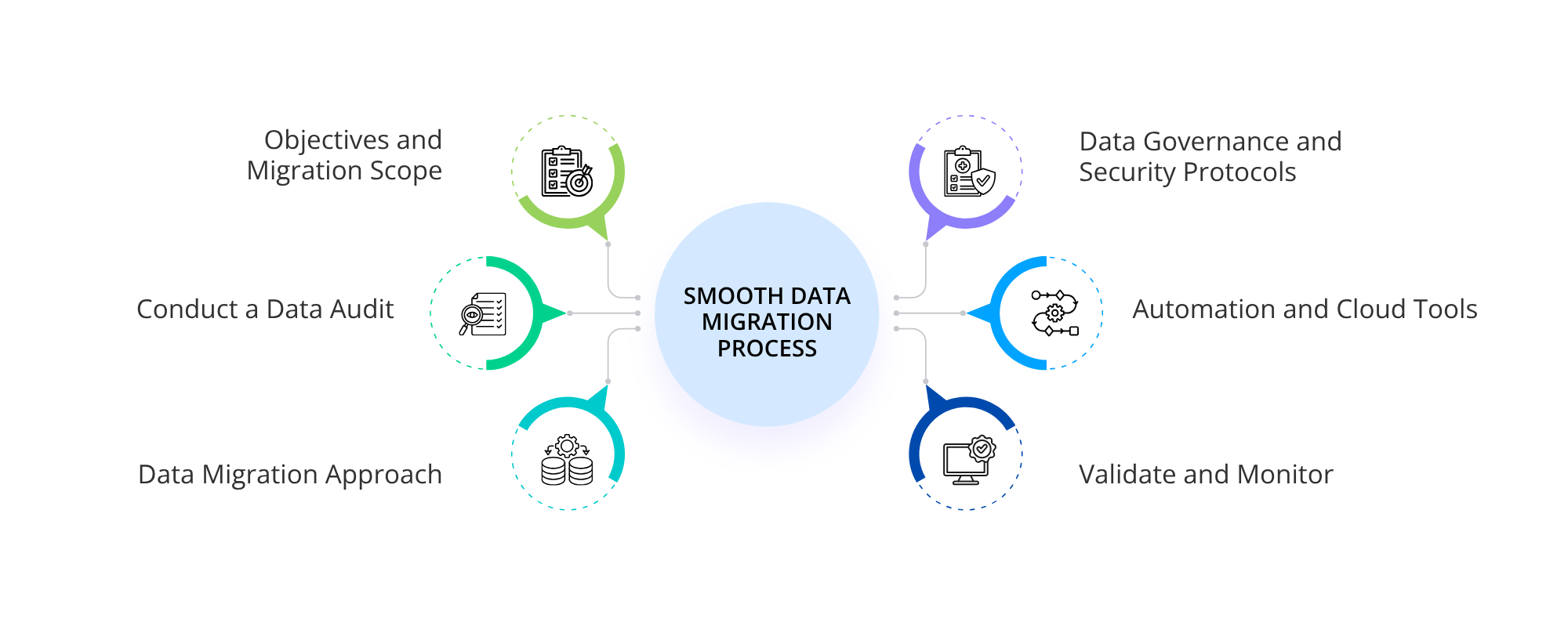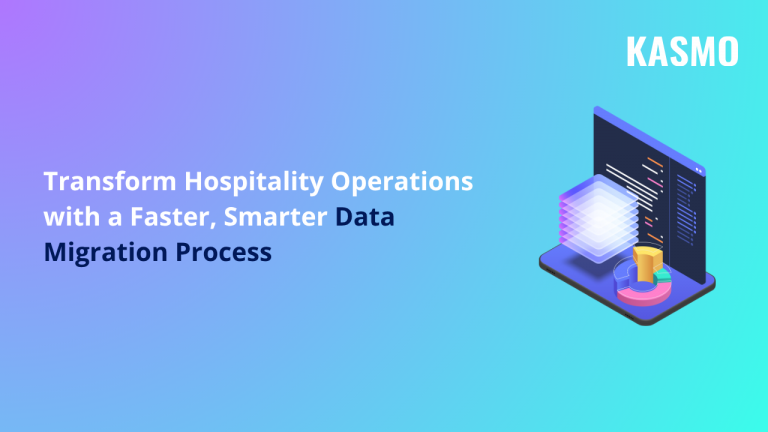Every interaction, new booking, and customer experience in hospitality generates valuable data. But when this information is scattered across outdated systems and lacks a data migration process, it limits how effectively hotels can use it to enhance operations and guest satisfaction.
According to Gartner, 39% of hospitality businesses rely on third-party software, 26% use manual methods, and 25% have no system in place for daily hotel management. This fragmented approach and use of legacy systems lead to inefficiencies, poor visibility, data security vulnerabilities, and lost revenue potential.
Data migration eliminates this major challenge by transferring information from traditional systems to advanced cloud-based platforms. It enables hospitality brands to centralize guest data, automate operations, and power intelligent decision-making across departments. Beyond just moving data, the data migration process improves hospitality management and guest experiences.
In this blog, we’ll explore the role of data migration in hospitality business growth, key challenges, strategies for a transition, and how Snowflake simplifies the entire process with secure and data-driven solutions.
What Is Data Migration in Hospitality?
Data migration refers to the process of transferring data from legacy systems to modern, cloud-based environments. In the hospitality sector, it includes transferring guests, bookings, and operational data from an old system to a new one. This process is about modernizing and optimizing data for better decision-making and improving guest experiences.
Hotels, resorts, and travel businesses rely on multiple systems such as Property Management Systems (PMS), Customer Relationship Management (CRM) tools, Point-of-Sale (POS) systems, booking engines, etc. As data is present on different platforms, creating data silos, this in turn limits visibility and the ability to create personalized guest journeys. Data migration helps to consolidate all this information into a unified, scalable cloud data platform. The process involves extracting data from source systems, transforming it into a consistent and usable format, and loading it into the target system to gain valuable insights.
Why Data Migration Is Essential for Hospitality Growth?
The data migration process is a strategic approach for hospitality businesses to enhance growth and improve guest experience. Using modern platforms and data management solutions also brings an added competitive advantage. Cloud data systems provide instant access to data, enabling better coordination between departments like reservations, front desks, and housekeeping. This helps managers gain insights and make faster decisions on occupancy, pricing, and staffing.
Migrating to the cloud eliminates the use of outdated on-premises systems and hardware maintenance costs. It also offers higher scalability, allowing hospitality brands to manage fluctuations in demand and seasonal crowds. Platforms also include enterprise-grade security features, including encryption, access controls, and compliance with GDPR and other data protection standards essential for protecting guest information.
Another important need is predictive analytics. With centralized, high-quality data, hotels can use AI and machine learning to predict demand, occupancy and automate pricing or upsell recommendations. All these are essential factors to manage operations and increase guest satisfaction.
Common Challenges in the Data Migration Process
Data migration can be complex for large hospitality businesses dealing with legacy systems and high volumes of guest data. Below are a few common challenges to be understood:
Data Silos and Quality
Hospitality organizations often store data in multiple systems. These systems may use different data formats and structures, and consist of incomplete, duplicate, or outdated data, which can slow down migration and affect reporting accuracy. Data cleansing and validation are essential to ensure accuracy and reliability in the new environment.
System Downtime
Migrating large datasets while maintaining operational efficiency can be challenging. Without proper planning, businesses risk system downtime that affects bookings, check-ins, or guest services.
Security and Compliance
Guest data is sensitive as it includes personal and payment information. So, it requires strict protection and data privacy initiatives. Implementing encryption and regulatory compliance during transfer can efficiently prevent data breaches or legal risks.
Integration with Existing Applications
Post-migration, new systems must integrate properly with operational tools, PMS, CRM, and marketing platforms. Poor integration can lead to data fragmentation and reduce the effectiveness of migration.
Mapping Errors
Mapping errors during data migration are challenging. It can lead to operational disruptions, financial losses, compromised guest experiences, and privacy issues. This is due to errors typically caused due to misaligned data fields, incompatible formats, and poor data quality in legacy systems.
Strategies for Implementing a Smooth Data Migration Process
Executing a successful data migration requires detailed planning, clear governance, and the right cloud infrastructure. Migrating from legacy systems to a modern data platform becomes easy by following the right approach, reducing minimal disruption, and maximizing value. Key strategies of the efficient data migration process include:

Clear Objectives and Migration Scope
Before initiating the data migration process, understand its purpose and the data you want to move. Set clear goals like improving guest analytics, enabling predictive insights, or modernizing IT infrastructure. Defining the scope ensures teams focus on relevant datasets and prioritize critical systems like PMS, CRM, and POS that directly impact operations and guest experience.
Conduct a Data Audit
Performing a data assessment before migration helps uncover data quality issues, duplication, and inconsistencies. This step ensures that only accurate and valuable data is migrated. For hospitality businesses managing years of bookings, loyalty data, and guest feedback, a data audit helps to avoid cluttering the new data systems with outdated information.
Choose the Right Data Migration Approach
Selecting an appropriate migration strategy depends on system complexity and business needs. Common approaches include big bang migration, where all data is moved, or phased migration, which is a stage-wise process, reducing risk and allowing validation at each step. Hospitality brands can choose strategies depending on their needs and goals.
Data Governance and Security Protocols
During migration, guest information must be handled with the highest level of security. Key responsibilities include maintaining data accuracy, protecting guest privacy, and building trust with customers. Implement role-based access, encryption, and compliance checks like GDPR and PCI DSS. Adhering to strong governance policies builds and maintains trust with guests.
Automation and Cloud Tools
Automation tools and cloud platforms enable smoother data mapping, validation, and transformation. Using ETL/ELT pipelines and automated workflows reduces manual intervention and speeds up data ingestion processes. Cloud data platforms like Snowflake allow secure, scalable, and zero-downtime migration.
Validate and Monitor
Post-migration, validating the entire process is essential. It includes verifying data accuracy, consistency, and performance in the new environment. Hospitality organizations should conduct pilot runs to ensure guest booking systems, reporting dashboards, and APIs function after migration. Continuous monitoring helps to quickly identify and resolve any anomalies.
How Snowflake Simplifies the Data Migration in Hospitality?
Migrating data in the hospitality industry involves multiple systems, large volumes of data, and regular updates. This can be done easily and effectively by using the Snowflake data platform. Snowflake simplifies and accelerates the data migration process, helping hospitality management to create a unified, scalable, and secure cloud environment.
Build Unified Data Platform
Snowflake combines all the data from different sources, like PMS, CRM, POS, etc, into a single, cloud-based system. Data migration helps to create a 360-degree view of each guest’s data. Snowflake also supports structured, semi-structured, and unstructured data to easily migrate from legacy systems. All this helps hospitality business owners handle seasonal data spikes without performance issues or high cost.
Zero-Copy Cloning Reduces Down-Time
Snowflake’s architecture supports near-zero downtime migration, which helps to operate 24/7. Zero-copy cloning is effective in creating instant, cost-effective copies of databases without physically duplicating data. They can be used for testing and validation without affecting the original data or requiring system downtime. Data replication and continuous synchronization improve operations like reservations, check-ins, or inventory updates.
Easy Integration with Existing Systems
The major advantage of using the Snowflake platform is its ability to integrate effortlessly with existing ETL tools, data warehouses, and third-party systems. This makes it easier for hospitality companies to connect operational data from multiple systems to cloud environments. It also supports multi-cloud and cross-cloud capabilities, giving businesses flexibility and control over their data strategy.
Automated Data Transformation and Optimization
With Snowflake’s ELT (Extract, Load, Transform) approach, data can be loaded into the platform first and transformed using SQL-based transformations later. This reduces complexity and manual efforts. Automated data optimization features like compression, clustering, and query acceleration enhance data reliability and cost efficiency.
Provides Advanced Analytics
Once data is migrated to Snowflake, hospitality businesses can access real-time analytics to optimize pricing, occupancy, marketing, and guest engagement. Snowflake AI Data Cloud uses data and artificial intelligence to drive automation and hyper-personalized experiences. It also helps agents to improve customer service by responding faster, anticipating guest needs, and using chatbots. These capabilities enhance hospitality businesses and provide personalized guest experiences.
Conclusion
Data migration acts as a growth booster in the hospitality management sector. Businesses need to start evaluating their current systems and set migration goals to personalize the guest experience. Moving to cloud-based platforms improves agility, operational efficiency, and provides deeper insights. With Snowflake’s AI-powered Data Cloud, migration becomes faster and more secure. A well-executed data migration process empowers hospitality leaders to unify fragmented systems, reduce inefficiencies, and make data-driven decisions.
As a trusted Snowflake implementation partner, Kasmo helps hospitality businesses simplify and accelerate their data migration process using Snowflake. Our experts guide each stage from eliminating legacy systems and designing data migration strategies to ensure governance and integration with the current system. Together with Snowflake’s cloud architecture, Kasmo helps hotels and travel businesses gain unified visibility, accelerate growth, and deliver guest experiences.




